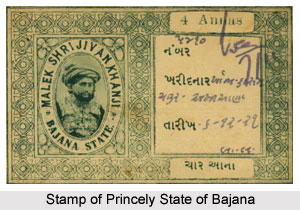 The Princely State of Bajana was one of the prominent princely states of India that were administered by native rulers or Indian princes under the indirect control of the British Government of India. The state covered a total area of 183.12 sq m and comprised of a total population of 13,996 in the year 1941. Bajana state included around 29 villages and was located in the northern Kathiawar on the southern coast of the Lesser Rann of Kutch. It was constituted of 3 asymmetrical blocks of land which were segregated by a British exclave that belonged to the Collectorate of Ahmedabad. The native state was bounded by the region of Patdi in the north; by the British Ahmedabad and Vithalgadh in the east; by Lakhtar in the south, by Dhrangadhra in the west; and by Cutch in the northwest. At present, Bajana is a village in the Buxwaha Tehsil, situated in the district of Chhatarpur, Madhya Pradesh, India.
The Princely State of Bajana was one of the prominent princely states of India that were administered by native rulers or Indian princes under the indirect control of the British Government of India. The state covered a total area of 183.12 sq m and comprised of a total population of 13,996 in the year 1941. Bajana state included around 29 villages and was located in the northern Kathiawar on the southern coast of the Lesser Rann of Kutch. It was constituted of 3 asymmetrical blocks of land which were segregated by a British exclave that belonged to the Collectorate of Ahmedabad. The native state was bounded by the region of Patdi in the north; by the British Ahmedabad and Vithalgadh in the east; by Lakhtar in the south, by Dhrangadhra in the west; and by Cutch in the northwest. At present, Bajana is a village in the Buxwaha Tehsil, situated in the district of Chhatarpur, Madhya Pradesh, India.
History of Princely State of Bajana
The Jats from Sind was the ruling family of Bajana, who were granted the area around Bajana, under the leadership of Malek Hadoj. The Mughal viceroy of Ahmedabad, Mohammed Begada, presented them the land for providing loyal services in the deposition of the Rajput kingdom of Champaner in the year 1484. Later the family converted to Islam. After a period of time, due to some conflict, the Mughal viceroy Mohammed Begada resumed the estate and divided it. The territory of Bajana was retained with Malek Hadoj, where as the regions of Vanod and Sitapur were given to Malek Lakha; and Valivada was given to Malek Iso.
The Princely State of Bajana was incorporated as a part of the Baroda Agency, Western India States Agency and Gujarat, and was also under the administrative control of Eastern Kathiawar Agency. The native ruler of the Indian princely state had autonomous power for the internal administration of the state and held the title of Darbar Saheb, but was generally styled as Malek Shri. The Indian Prince of Bajana state had restricted civil and criminal jurisdiction. The state did not pay any tribute to the other princely state of India. Bajana state ranked 34th among the states of Western India. It was one of the original constituent members of the Chamber of Princes, a number of smaller states indirectly represented by 12 princes who were elected periodically by them.
In December, 1943 the princely state of Bajana was attached to Baroda under the 1943 Attachment Scheme. The region was one of the 15 second stage states which initially refused to cooperate with the attaching of states. After the country gained independence in the year 1947, the state was acceded to the Union of India.
Rulers of Princely State of Bajana
The chronology of the rulers of the princely state of Bajana is discussed as follows -
* Malek Shri Piroj Khan
* Malek Shri Suraj Mal III
* Malek Shri Dariya Khan
* Malek Shri Nasib Khanji Dariya Khanji
* Malek Shri Jivan Khan Nasib Khan
* Malek Shri Kamal Khan Jivan Khan
* Malek Shri Bismilla Khan Kamal Khan






































